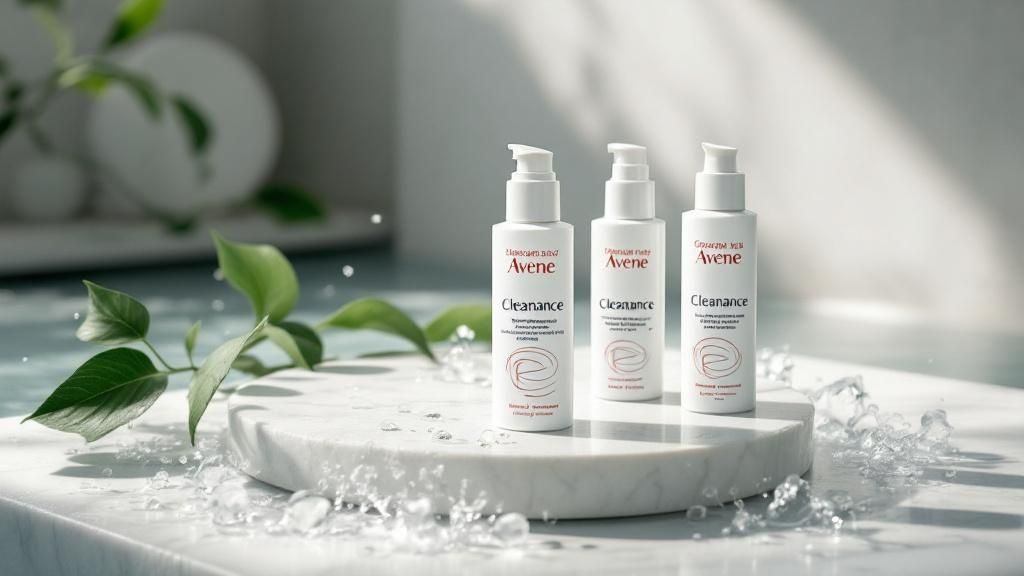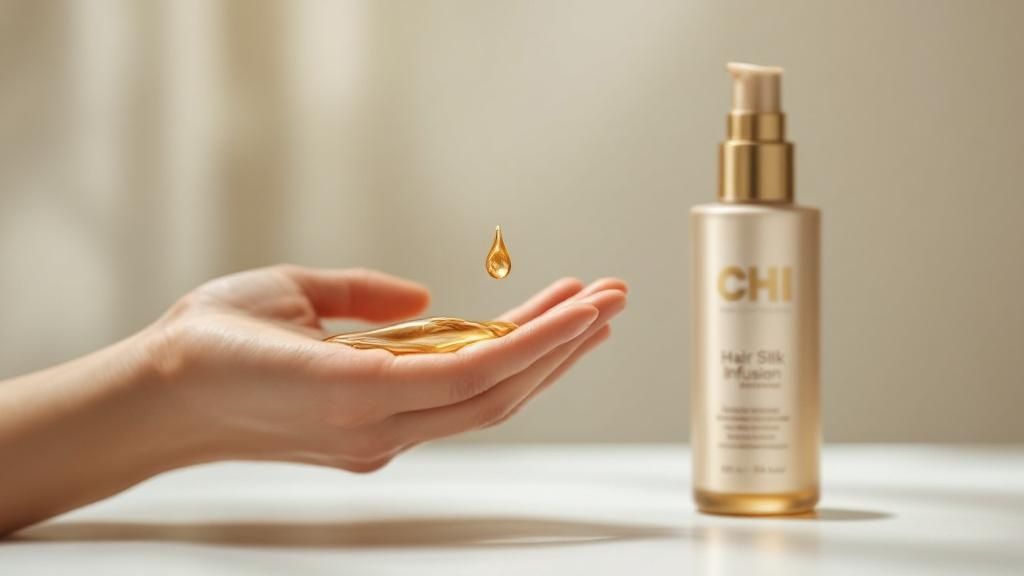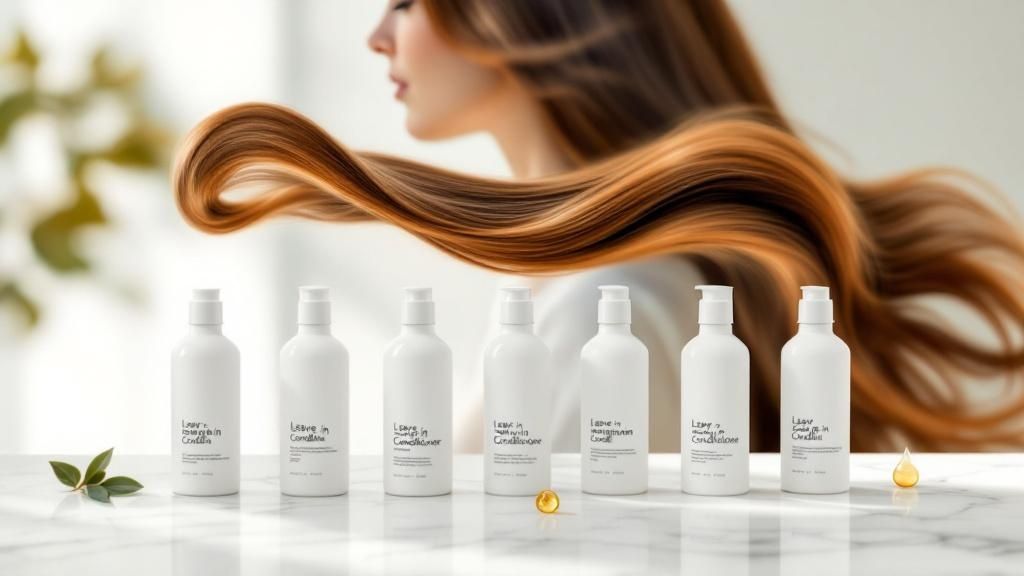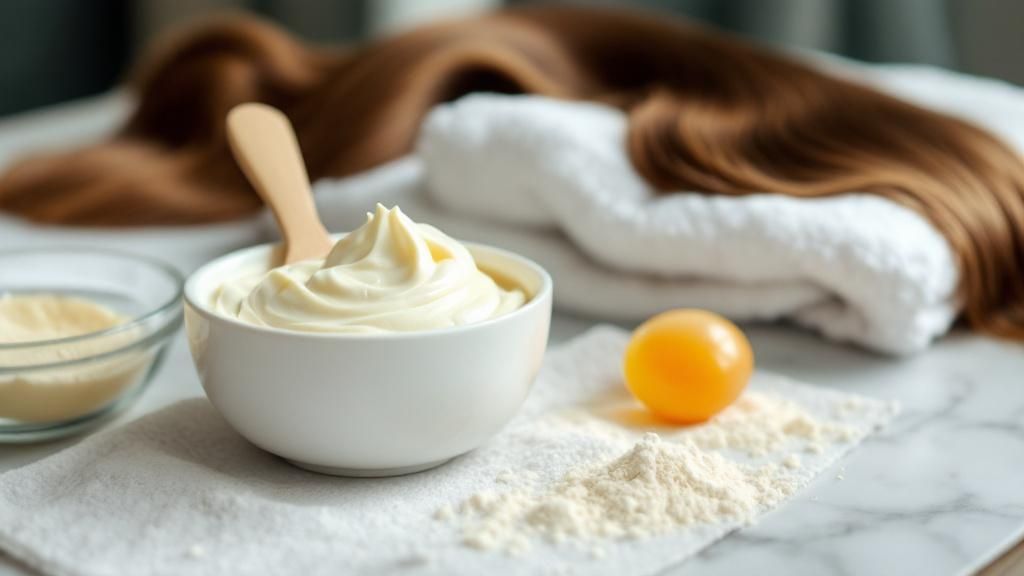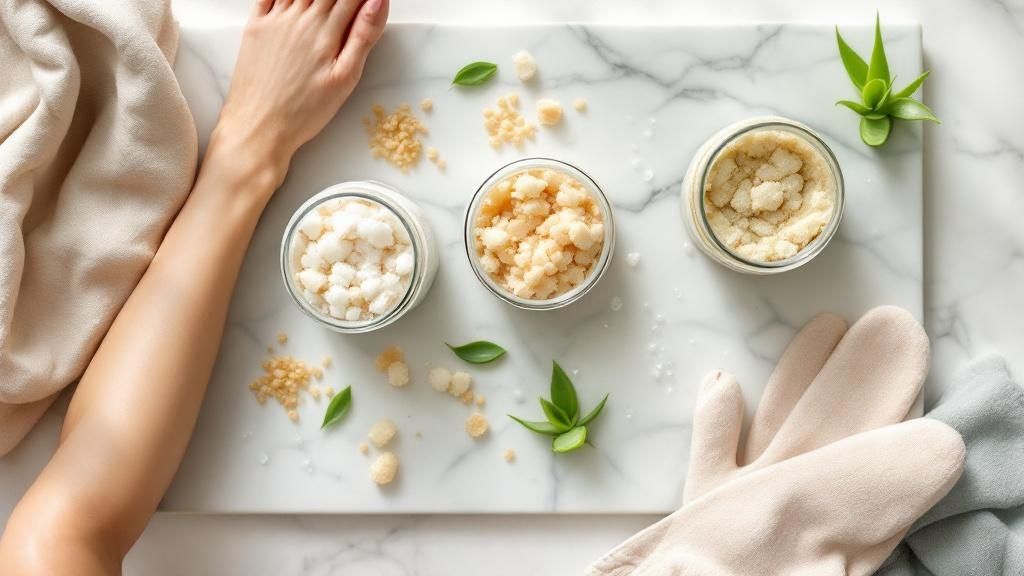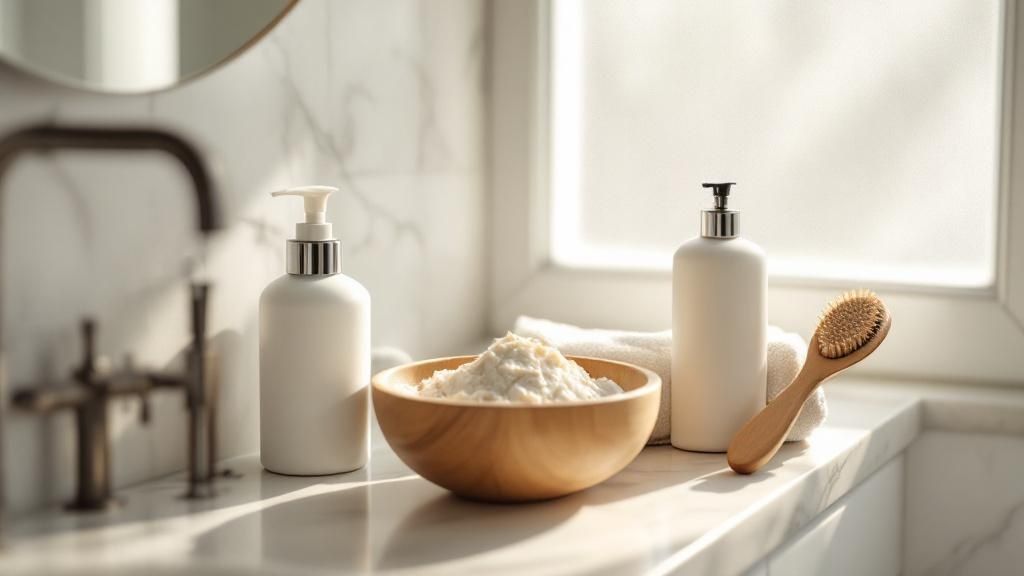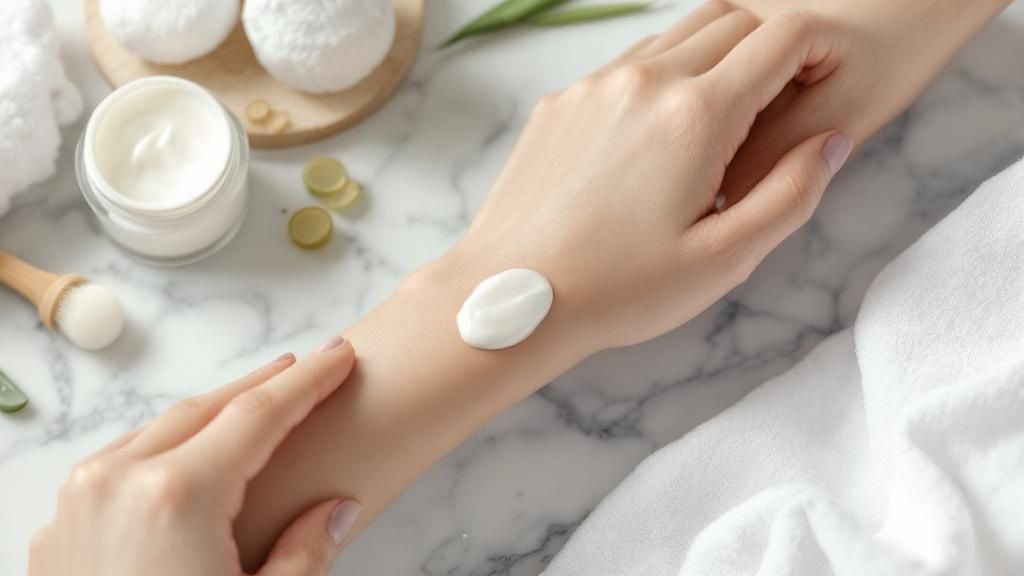
Best Body Care Routine for Dry Skin | Expert Tips & Products
Before you can build an effective body care routine for dry skin, you first have to understand why your skin feels so parched. For those of us living in Egypt, the environment is often the biggest culprit. This makes a consistent, well-planned routine absolutely essential for keeping your skin hydrated and comfortable.
Why Your Skin Feels So Dry in Egypt
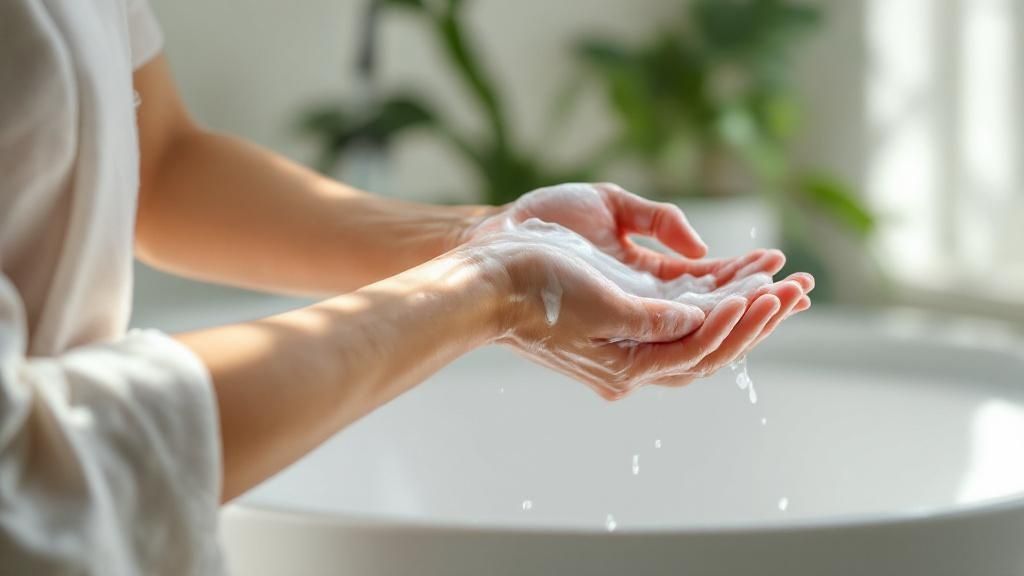
If you're constantly dealing with skin that feels tight, flaky, or itchy, you’re certainly not alone. Life in Egypt means our skin is up against an arid desert climate with very low humidity. This dry air essentially acts like a sponge, pulling moisture right out of your skin all day long.
This constant moisture drain weakens your skin’s natural protective barrier. When that barrier is compromised, it can’t hold onto water or properly defend itself against irritants. This creates a frustrating cycle of dryness and discomfort. It's why just slathering on a single layer of lotion can feel like a temporary fix instead of a real, lasting solution.
The Scale of the Problem
The truth is, dry skin is a major dermatological issue across the country. Studies show that between 35-40% of Egyptians report symptoms like itching and flaking directly related to our climate.
A 2021 survey highlighted a big gap: while the problem is incredibly common, truly effective routines aren't. It found that only about 25% of people actually follow a dedicated body care plan. Most of us tend to moisturise sporadically, which just isn't enough to provide real relief. You can read more about these findings in the full study on dermatology in Egypt.
The key takeaway? Beating environmental dryness requires more than just a bit of cream now and then. It demands a consistent, multi-step approach that cleanses gently, deeply hydrates, and—most importantly—locks that moisture in.
Your Essential Dry Skin Body Care Plan
Putting together a routine that actually works for dry skin doesn't have to be complicated. It all comes down to a few core actions you do daily and weekly. These steps work together to rebuild and strengthen your skin's barrier, creating a shield that both adds moisture back and prevents it from escaping in the future.
Before we get into the nitty-gritty of each step, let's look at a quick overview. This table summarises the foundational habits for achieving healthy, hydrated skin, even in a challenging climate like ours.
Your Essential Dry Skin Body Care Plan
| Action | Frequency | Key Benefit |
|---|---|---|
| Gentle Cleansing | Daily | Washes away impurities without stripping essential oils. |
| Strategic Exfoliation | 1-2 times/week | Removes dead skin cells so moisturisers can absorb better. |
| Immediate Moisturising | Daily (Post-Shower) | Locks in hydration on damp skin for maximum effect. |
| Protective Measures | Daily | Shields skin from sun and wind to prevent moisture loss. |
Think of these as the non-negotiables. Getting these four things right will form the backbone of your entire body care strategy, setting you up for success.
How to Cleanse Without Stripping Your Skin
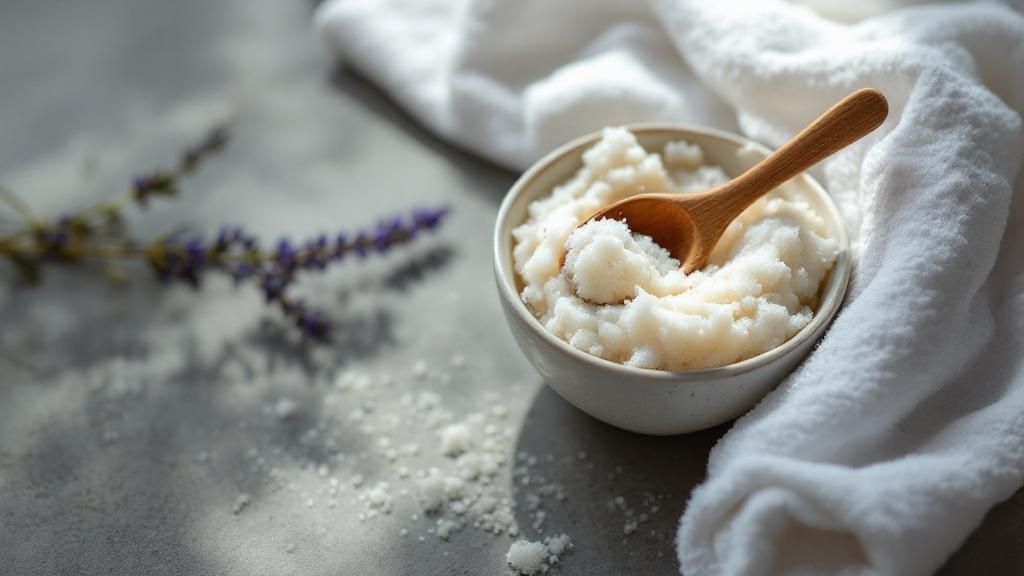
It all starts in the shower. A solid body care routine for dry skin is built on a gentle foundation, and if you get the cleansing step wrong, everything else is an uphill battle. Using the wrong body wash can strip away your skin's precious natural oils, leaving it tight, itchy, and crying out for moisture before you’ve even reached for a towel.
Many of us grew up with squeaky-clean soaps that produce a mountain of lather, but those harsh detergents are often the main culprits behind a compromised moisture barrier. Your goal is to find a cleanser that cleans effectively while keeping that protective barrier happy and intact. Think of choosing your body wash with the same care you'd use for your facial cleanser.
Finding The Right Cleanser
The secret lies in looking past the bubbles and focusing on the ingredient list. The first thing to do is steer clear of sulphates. While they’re great at creating that satisfying foam, they're infamous for stripping moisture from the skin.
Instead, you want to be on the lookout for cleansers packed with ingredients that nourish and hydrate. Here are the true heroes for dry skin:
- Ceramides: These are lipids, or fats, that are fundamental to your skin's structure. They act like the cement between skin cells, locking in moisture and keeping irritants out.
- Hyaluronic Acid: This incredible humectant is a moisture magnet, capable of holding up to 1,000 times its weight in water to plump and hydrate your skin from within.
- Glycerin: Another fantastic humectant that draws moisture from the air right into your skin's outer layer, providing a much-needed drink.
- Shea Butter: A classic for a reason. It's loaded with fatty acids and vitamins that deliver deep moisture and soothe irritated, dry patches.
A brilliant example that gets this right is the CeraVe Hydrating Cleanser. It’s a favourite among dermatologists because it’s loaded with both ceramides and hyaluronic acid to actively help restore the skin’s barrier as you wash.
Master Your Shower Technique
It’s not just about what you use, but how you use it. Your shower habits can make or break your skin's hydration levels, and a few simple tweaks can lead to a world of difference.
Honestly, the two biggest mistakes I see people with dry skin make are taking showers that are way too hot or far too long. Both are a fast track to stripping away that protective lipid layer, leaving your skin exposed and dehydrated.
Protect your skin by weaving these habits into your daily routine:
- Turn Down the Heat: I know a steaming hot shower feels amazing, but your skin will thank you for switching to lukewarm water. It cleans just as well without scalding away your natural oils.
- Keep it Short and Sweet: Try to limit your showers to between 5 and 10 minutes. The longer you stay under the water, especially hot water, the more moisture your skin loses.
- Pat, Don't Rub: When you get out, grab a soft towel and gently pat your skin dry. Vigorous rubbing creates friction and can irritate delicate skin. Patting also leaves your skin slightly damp—the perfect canvas for your moisturiser to lock in all that hydration.
Exfoliating Dry Skin the Right Way
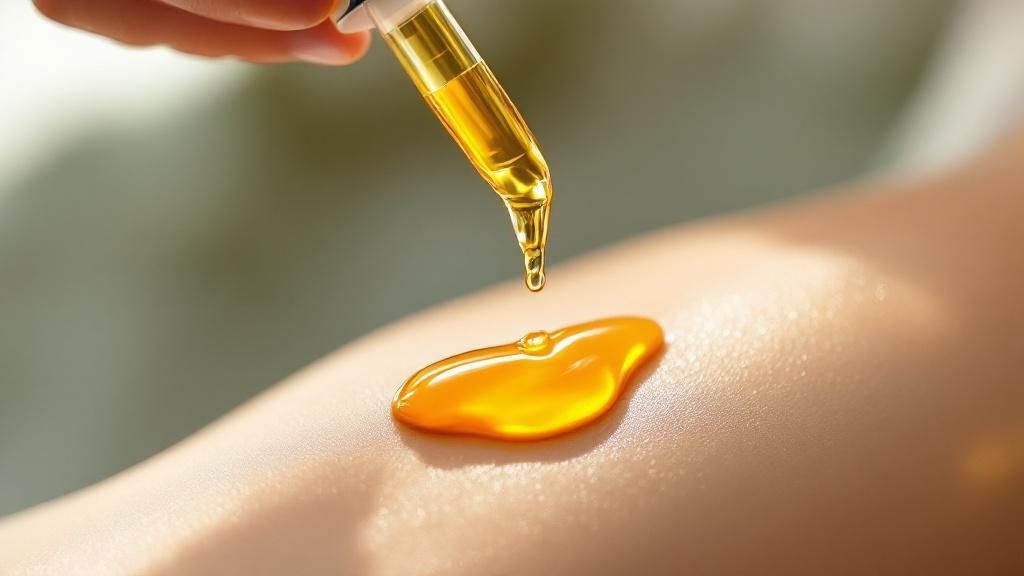 I know what you might be thinking—scrubbing skin that’s already dry and delicate? It sounds like the last thing you should do. But when done thoughtfully, exfoliation is an absolute game-changer in a body care routine for dry skin.
I know what you might be thinking—scrubbing skin that’s already dry and delicate? It sounds like the last thing you should do. But when done thoughtfully, exfoliation is an absolute game-changer in a body care routine for dry skin.
Gently clearing away that top layer of flaky, dead cells is what allows your moisturisers to actually sink in and do their job. Without it, even the richest creams just sit on the surface, struggling to get past that barrier of dullness. Let's walk through how to choose the right method, get the timing just right, and avoid the common pitfalls that lead to irritation.
Physical vs Chemical Exfoliation
When it comes to exfoliating your body, you’ve got two main options: physical or chemical. One isn’t necessarily better than the other; it really comes down to your skin’s tolerance and what feels right for you.
-
Physical Exfoliants: These are the scrubs most of us are familiar with. They use ingredients like fine-grain sugar, salt, or jojoba beads to manually buff away dead skin. You get that instant satisfaction of smoother skin right after you use one. A gentle sugar scrub on notoriously dry spots like elbows and knees, for example, can make them feel softer immediately. The key is to choose scrubs with small, smooth particles and always use a light hand to prevent creating tiny scratches, or micro-tears, on your skin.
-
Chemical Exfoliants: These products use acids or enzymes to dissolve the "glue" that holds dead skin cells together, letting them shed naturally. For dry skin, look for ingredients like lactic acid, glycolic acid, and urea. Lactic acid is a real hero because it’s a humectant, meaning it exfoliates and hydrates at the same time. A body lotion containing 10% urea, for instance, can work wonders over time to smooth texture without any scrubbing required.
How Often Should You Exfoliate?
This is where so many people trip up. It’s incredibly easy to over-exfoliate, which can damage your skin's moisture barrier and lead to redness, sensitivity, and even more dryness. When you have dry skin, less is definitely more.
Stick to exfoliating just once or twice a week. This is the sweet spot for sloughing off dullness and helping your products absorb better, all without stripping your skin. Always listen to your skin—if it feels tight or looks red, take a break.
Let’s say you’re dealing with flaky skin on your shins. You could use a gentle physical scrub in the shower on a Sunday. For the rest of the week, your only job is to slather on moisturiser. The following weekend, maybe you swap in a body lotion with lactic acid to maintain that smoothness. It’s this balanced rhythm that makes a body care routine for dry skin truly effective, giving your skin time to recover.
And the final, non-negotiable step? Always, always follow up with a rich, nourishing moisturiser to soothe and protect your freshly exfoliated skin.
Choosing and Applying Your Body Moisturiser
Once you've cleansed and exfoliated, your skin is primed and ready for the single most important step in any body care routine for dry skin: moisturising. This isn't just about slapping on some lotion; it's about deeply replenishing hydration and, crucially, locking it in for skin that feels comfortable all day long. Getting this right transforms your routine from a temporary fix into a powerful, barrier-repairing ritual.
So, how do you pick the right product? It all starts with reading the ingredients list. Think of it as recruiting a specialist team for your skin, where each member has a specific job to do to combat dryness and bring your skin back into balance.
Decoding Moisturiser Ingredients for Dry Skin
When your skin is dry, it’s not just thirsty—its protective barrier is compromised. You need ingredients that do more than just add a splash of moisture; you need ones that rebuild and reinforce that barrier to stop the good stuff from escaping.
To help you become a pro at scanning labels, here’s a quick look at the top hydrating ingredients and what they actually do for your skin.
| Ingredient | How It Works | Best For |
|---|---|---|
| Ceramides | These are lipids (fats) that naturally make up over 50% of your skin's barrier. They act like the mortar between your skin cells, holding everything together to lock in moisture and keep irritants out. | Rebuilding a compromised skin barrier and providing long-term structural support. |
| Hyaluronic Acid | A powerful humectant, this molecule acts like a magnet for water, holding up to 1,000 times its weight. It pulls moisture from the air and deeper skin layers to the surface. | An instant, noticeable boost of hydration and plumping up the skin. |
| Shea Butter | This rich emollient is packed with fatty acids and vitamins. It works by forming a protective seal on the skin's surface to prevent water loss while softening and soothing rough textures. | Intensely nourishing very dry, flaky, or chapped areas like elbows, knees, and heels. |
| Glycerin | Another reliable humectant, glycerin draws water into the outermost layer of your skin. It’s a gentle, effective, and common ingredient that helps keep skin feeling soft. | Everyday hydration and maintaining the skin's moisture balance. |
A product that combines these power players is often your best bet. For instance, a cult classic like the CeraVe Moisturizing Cream for Dry Skin is so well-loved because it uses both ceramides and hyaluronic acid. This dream team works together to deliver that one-two punch of immediate hydration and long-term barrier repair.
It's no surprise that savvy shoppers are catching on. A 2022 report on Egyptian skincare habits found that 68% of consumers with dry skin actively seek out products containing nourishing ingredients like shea butter. The same report noted that moisturisers account for roughly 40% of all skincare sales, which tells you just how vital this step is for everyone. You can dive deeper into these Egyptian consumer skincare insights on PubMed.
Picking the Right Texture for Your Skin's Mood
Beyond the ingredients, the feel of your moisturiser—whether it’s a lightweight lotion, a balanced cream, or a thick, decadent butter—matters a lot. The best choice often changes with the seasons, the time of day, or simply how parched your skin feels.

As you can see, richer textures like butters and ointments offer the most long-lasting hydration. This makes them perfect for tackling severely dry patches or for applying at night, giving your skin an intensive overnight recovery treatment. Lighter lotions are great for daytime use when you need something that absorbs quickly.
The Art of Application: Timing Is Everything
Finally, when you moisturise is just as critical as what you use. To get the absolute most out of your product, you need to master the "golden minute" rule.
The rule is incredibly simple but makes a world of difference: apply your moisturiser within a minute or two of stepping out of the shower.
Gently pat your skin with a towel, but leave it slightly damp. Applying your cream or lotion to damp skin helps trap that surface water, pulling it into your skin for much deeper, longer-lasting hydration. If you wait until your skin is bone-dry, you've missed the perfect window of opportunity.
By being deliberate about your ingredients, texture, and timing, you can elevate a simple daily task into the most effective part of your entire routine—leaving you with skin that feels soft, comfortable, and truly hydrated from within.
Lifestyle Habits That Support Hydrated Skin
A truly effective body care routine for dry skin extends far beyond your bathroom cabinet. While the right cleansers and moisturisers are non-negotiable, the choices you make every day are just as powerful in supporting your skin's hydration. Think of it as a team effort: the products you apply can only do their best work when your body is already creating a healthy, hydrated environment from the inside out.
It's not just about what you put on your skin; it’s about how you live your life. By making a few simple, conscious adjustments, you can dramatically improve your skin's health. This holistic approach is the real secret to moving past temporary fixes and achieving lasting comfort and radiance.
Feed Your Skin From Within
What you eat and drink has a direct and profound impact on your skin's ability to hold onto moisture. Your skin is your body's largest organ, and just like any other part of you, it needs the right fuel to function properly—especially when you’re up against the dry Egyptian climate.
Let's start with the obvious: hydration. The old "eight glasses a day" advice is a decent baseline, but your personal needs might be different. The key is consistency. Sipping water throughout the day keeps your internal hydration levels stable, providing the raw material your skin needs to stay plump and resilient.
Beyond water, what's on your plate is equally critical. Integrating healthy fats into your diet is essential for strengthening your skin’s natural moisture barrier. Some fantastic sources include:
- Avocados: They're full of monounsaturated fats and Vitamin E, which is brilliant for helping protect the skin from oxidative damage.
- Nuts and Seeds: Think almonds, walnuts, and flaxseeds. These are packed with omega-3 fatty acids that help lock in moisture from within.
- Olive Oil: A staple for a reason, it helps keep skin feeling soft and supple.
Create a Skin-Friendly Environment
Your immediate surroundings can either be an ally or an enemy in your battle against dryness. The arid air in Egypt—both outside and inside, thanks to ever-present air conditioning—is constantly working to pull moisture from your skin. Taking control of your environment can offer some serious relief.
One of the single best investments you can make for dry skin is a humidifier. Running one in your bedroom overnight puts precious moisture back into the air, creating a less taxing environment so your skin can repair itself without losing hydration while you sleep.
Protecting your skin from the elements is also crucial. The sun and harsh winds are notorious for weakening the skin barrier. For those days when your skin feels especially vulnerable or for tackling extreme dryness, a powerful barrier cream like the Isispharma Secalia Balm for Dry Skin can offer an extra layer of defence and intensive repair.
Lastly, don't overlook your wardrobe. Fabrics matter. Rough materials like wool can create friction and irritation, making dryness worse. Whenever possible, choose soft, breathable fabrics like cotton or silk to keep your skin calm and comfortable.
A Few Common Questions About Dry Body Care
Even when you have all the right products, diving into a new body care routine for dry skin can feel a bit uncertain. I get it. Skincare can be confusing, and a few lingering questions are perfectly normal. Let's clear up some of the most common ones I hear, so you can feel confident in your routine and finally get that soft, comfortable skin you're after.
How Long Until I See Real Results?
You'll probably feel some instant relief right after you slather on a good moisturiser – that tight, itchy feeling often subsides straight away. That’s the immediate payoff. But for the kind of deep, lasting improvement that truly changes your skin, you need to be consistent. It’s all about repairing your skin’s moisture barrier over time.
Think about your skin's natural rhythm. The cell turnover cycle, where your body sheds old, dry cells to make way for new ones, takes about 28 to 40 days. So, give it 2 to 4 weeks of daily care before you expect to see a real, noticeable difference in your skin's texture and overall hydration. If your skin is extremely dry, it might even take up to 6 weeks to see the full benefits. Patience and daily commitment are everything here.
Can I Just Use My Face Cream on My Body?
In a pinch? Absolutely. If you have a stubborn dry patch on your elbow, dabbing on a bit of your face cream won't do any harm. But as a regular, all-over solution, it’s not your best bet for a couple of key reasons.
The skin on your body is significantly thicker than the delicate skin on your face. Because of this, body lotions and butters are formulated differently. They often contain richer, heavier ingredients designed specifically to penetrate those tougher layers and seal in moisture effectively.
The goal is always hydration, but body-specific creams are built for covering large areas and are usually much more cost-effective. It's really about using the right tool for the job.
Are Natural or Organic Products Automatically Better for Dry Skin?
Not necessarily. While many natural ingredients are fantastic for skin, words like "natural" and "organic" on a label are mostly for marketing. They don't guarantee that a product is safer or more effective, especially for dry skin.
In fact, some powerful natural ingredients, like certain essential oils, can be surprisingly irritating if your skin is already sensitive or has a weakened barrier. On the flip side, many incredible lab-made ingredients are exceptionally gentle and have been rigorously tested and proven to be hydration heroes.
Instead of getting caught up in the "natural" claim, focus on what's actually in the bottle:
- Proven Hydrators: Look for powerhouse ingredients like ceramides, hyaluronic acid, shea butter, and glycerin.
- Fragrance-Free Formulas: Both synthetic and natural fragrances are very common culprits for irritating dry, sensitive skin.
- Dermatologist-Tested: This is a good sign that the product has been reviewed for safety and is less likely to cause a reaction.
Why Does My Skin Get So Much Itchier in Winter?
Ah, the dreaded "winter itch." This is a classic problem, even in Egypt's milder winters, and it all comes down to one thing: a major drop in humidity.
When the cool outdoor air, which naturally holds less moisture, meets the dry indoor air from heaters, the environment basically starts pulling moisture right out of your skin. This constant evaporation disrupts your skin’s protective barrier, leading to that frustrating cycle of dryness, flaking, and that non-stop itch. This is precisely why sticking to a solid body care routine is even more critical during the colder months.
At lo.la, we know that the right products are the cornerstone of any great routine. We've curated a collection of authentic skincare from top international brands, all specifically chosen to tackle dryness and bring your skin back to health. Find your perfect moisturiser and start your journey to hydrated skin today at lolabeautyshop.com.










